
The Natural Georgia Series: The Flint River

 |
The Natural Georgia Series: The Flint River |
 |
 Rivers
are among the most human-impacted ecological systems in the world. As people
colonize a continent they tend to follow river corridors, building settlements
along the way. As commerce develops, rivers become important transportation
routes. To aid river traffic, channels are dredged and cleared. As cities grow,
rivers are used both as a source of water and to treat municipal and industrial
wastes. Rivers receive runoff from storm sewers and disturbed areas. Reservoirs
and levees are constructed to control floods and store water for later use.
All of these activities contribute to the degradation of natural river habitat,
alteration of river flows, and pollution of river water. The net affect of human
activity has been a loss of native river flora and fauna. For example, in North
America over 20 percent of freshwater snails and fishes, over 30 percent of
crayfishes, and almost 50 percent of mussels are in danger of extinction. In
a recent survey, only 2 percent of North America's total river miles were rated
as being in a high-quality natural condition. Scientists and river managers
are recognizing that rivers can be restored. Critical to the recovery of river
health is the reestablishment of seasonal floods and conservation or restoration
of streamside forests and wetlands. Once these components are reestablished,
a river's natural capacity for self-purification will result in recovery of
water quality and river habitat. However, when a species is lost, it cannot
be recovered.
Rivers
are among the most human-impacted ecological systems in the world. As people
colonize a continent they tend to follow river corridors, building settlements
along the way. As commerce develops, rivers become important transportation
routes. To aid river traffic, channels are dredged and cleared. As cities grow,
rivers are used both as a source of water and to treat municipal and industrial
wastes. Rivers receive runoff from storm sewers and disturbed areas. Reservoirs
and levees are constructed to control floods and store water for later use.
All of these activities contribute to the degradation of natural river habitat,
alteration of river flows, and pollution of river water. The net affect of human
activity has been a loss of native river flora and fauna. For example, in North
America over 20 percent of freshwater snails and fishes, over 30 percent of
crayfishes, and almost 50 percent of mussels are in danger of extinction. In
a recent survey, only 2 percent of North America's total river miles were rated
as being in a high-quality natural condition. Scientists and river managers
are recognizing that rivers can be restored. Critical to the recovery of river
health is the reestablishment of seasonal floods and conservation or restoration
of streamside forests and wetlands. Once these components are reestablished,
a river's natural capacity for self-purification will result in recovery of
water quality and river habitat. However, when a species is lost, it cannot
be recovered.
The Flint River of Georgia is a river that still maintains high-quality river habitat, unpolluted waters, and an abundance of native species in some sections. Even though the river begins in urban Atlanta and crosses an agricultural landscape, streamside forests, swamps, and unimpeded river flow allow natural self-purification to occur. The Flint River and areas adjacent provide habitat for many interesting and unusual plants and animals.
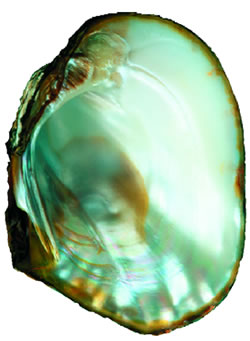
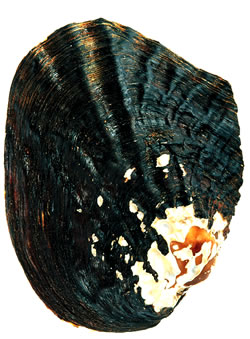 Historically,
29 species of freshwater mussels were found in the Flint River and its tributaries,
making it one of the most diverse rivers for freshwater mussels in the state
of Georgia. In the early 1990s, surveys found that 22 species of freshwater
mussels still occurred in the Flint River and its tributaries.
Historically,
29 species of freshwater mussels were found in the Flint River and its tributaries,
making it one of the most diverse rivers for freshwater mussels in the state
of Georgia. In the early 1990s, surveys found that 22 species of freshwater
mussels still occurred in the Flint River and its tributaries.
Freshwater mussels are sedentary creatures that live on river bottoms or burrow into river sediments. They are filter feeders; they feed by drawing water into their bodies with siphons and capture organic particles and microscopic algae with special structures on their gills. Freshwater mussels have an unusual life cycle that depends on freshwater fish. Once mussels eggs are fertilized, immature mussels, called glochidia, are released into river water where they must find a fish host. They attach to the gills or other body surface of fish and development occurs. They then release from the fish and settle to the river bottom where they mature. Some mussels produce elaborate lures to attract fish hosts and many produce large numbers of glochidia.
One of the largest freshwater mussels in the Flint River is the washboard (Megalonaias nervosa), which may grow to a length of 8 inches. The washboard has a dark brown almost round shell. Its name comes from the large ridges on the outside of the shell which resemble the ridges on an antique washboard. The inside of the shell is iridescent white to bluish-white. The washboard is a large river species and prefers deeper midchannel areas with swift current. It is often found in areas with sand or limestone rock bottoms. The washboard is still abundant in the Flint River.
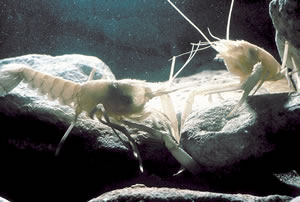 The
seeps, springs, and caves that are found in the karst topography of south Georgia
provide habitat for a unique and diverse faunal community. Underground and cave-dwelling
species are highly endemic, or limited in their geographical distribution. A
survey of obligate cave fauna of the United States determined that over 60 percent
of these species were restricted in distribution to only one county, with some
species found only in a single cave or spring.
The
seeps, springs, and caves that are found in the karst topography of south Georgia
provide habitat for a unique and diverse faunal community. Underground and cave-dwelling
species are highly endemic, or limited in their geographical distribution. A
survey of obligate cave fauna of the United States determined that over 60 percent
of these species were restricted in distribution to only one county, with some
species found only in a single cave or spring.
These subterranean faunal communities function in an ecological system with a significantly restricted energy input. For most of these systems, primary energy inputs come from nutrients and detritus transported by infiltrating groundwater. Some researchers have also suggested that inputs from bat guano deposited in caves and bacteria growing in the subterranean waters are important subsidies for the food web of these ecosystems. Much remains to be learned about the ecology of these subterranean systems, but we do know that they are very sensitive and vulnerable to impacts such as pollutants and sediments that infiltrate groundwater and altered hydrology.
The most specialized subterranean creatures are known as troglobites and spend their entire lives underground. Species that comprise this group often exhibit extreme morphological adaptations to their environment, such as lack of pigmentation, reduction or loss of eyes, and development of accessory sensory structures. Two of the most well-known troglobites from southwest Georgia include the Georgia blind cave salamander (Haideotriton wallacei) and the Dougherty Plain cave crayfish (Cambarus cryptodytes).
The Georgia blind cave salamander was discovered in 1939 by an engineer with the Dougherty County water system when a specimen was lifted to the top of a 200 foot well. These salamanders range in size from 1 to 3 inches and vary in color from a translucent pale pink to white. Other adaptations to their unusual aquatic environment are bright red feathery external gills and a finned tail.
The Dougherty Plain cave crayfish is another subterranean species that was discovered from a well. Found in Jackson County, FL in 1941, this crayfish has subsequently been reported from caves in southwest Georgia and neighboring parts of the Florida panhandle. It shares the typical subterranean adaptations of lack of pigmentation and reduced eyes.
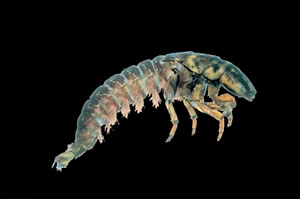 The
net-spinning caddisflies (Family Hydropsychidae) are among the most abundant
type of caddisfly in the rivers of Georgia. One hundred and forty-five species
occur in North America, although it is not known how many of these occur in
the Flint River. The immature or larval form of a net-spinning caddisfly resembles
a small caterpillar and lives in the water. They have a rounded armored head,
three pairs of legs, plates on the back of the first three body segments, and
a pair of hook-like tails. At maturity the larvae range from 0.5 to 1 inch in
length.
The
net-spinning caddisflies (Family Hydropsychidae) are among the most abundant
type of caddisfly in the rivers of Georgia. One hundred and forty-five species
occur in North America, although it is not known how many of these occur in
the Flint River. The immature or larval form of a net-spinning caddisfly resembles
a small caterpillar and lives in the water. They have a rounded armored head,
three pairs of legs, plates on the back of the first three body segments, and
a pair of hook-like tails. At maturity the larvae range from 0.5 to 1 inch in
length.
Net-spinning caddisflies produce silk, which they use to construct elaborate tent-like homes called retreats on the surface of rocks or wood. In the Flint River, boulders and pieces of submerged wood may be covered with hundreds of retreats. Net-spinning caddisflies are filter-feeders and use nets woven into their retreats to capture small animals or organic particles from river water. They use brush-like mouthparts to remove food captured in their nets. Each species of net-spinning caddisfly produces a unique retreat and capture net. When the larvae complete their growth, they withdraw into their retreat and gradually develop wings. The adult caddisfly swims to the surface and emerges from the water.
The caddisfly resembles a small moth and its wings are folded tent-like over its body when resting. Adult caddisflies live for only a few days. During this time they mate and the female deposits eggs in the water to complete the life cycle.
 Dobsonfly
larvae (Corydalus cornutus) are abundant in the Flint River but seldom
observed. Growing to a length of 3 inches, they have large square heads with
distinct yellow and brown markings and large strong jaws. They have three pairs
of legs and a muscular body with long, lateral filaments. Dobsonfly larvae,
also called hellgrammites or 'gator-fleas, live beneath rocks and boulders in
swiftly flowing sections of a river. They can be found in abundance in the shoals
of the Flint River or its tributaries.
Dobsonfly
larvae (Corydalus cornutus) are abundant in the Flint River but seldom
observed. Growing to a length of 3 inches, they have large square heads with
distinct yellow and brown markings and large strong jaws. They have three pairs
of legs and a muscular body with long, lateral filaments. Dobsonfly larvae,
also called hellgrammites or 'gator-fleas, live beneath rocks and boulders in
swiftly flowing sections of a river. They can be found in abundance in the shoals
of the Flint River or its tributaries.
Dobsonfly larvae are predators. They use their strong jaws to capture other smaller aquatic animals. Their jaws are also used for defense and if handled carelessly a dobsonfly larva can deliver a severe pinch.
In the Flint River, dobsonfly larvae require a year to complete their larval growth. They mature in early summer, crawl to the stream bank, and burrow into moist soil. Over the next few weeks they gradually develop wings and emerge from the soil to find a mate. The adults do not feed and are clumsy fliers, spending most of their time on the streambank or in vegetation. Following mating, females deposit eggs in masses on vegetation or on structures overhanging the river. Egg masses are chalky white and circular, about 1 inch in diameter. They are commonly observed in early summer. Dobsonfly larvae are a preferred food of shoal bass and can be used as bait.
Burrowing mayflies of the family Ephemeridae are common in silty or muddy bottom, slow-moving streams across North America. In the Flint River, the genus Hexagenia the most common representative of this group. Hexagenia mayflies spend most of their lives as an immature form or nymph. The nymph has two long tusks, 3 pairs of legs, and feathery gills on its body. The front legs are enlarged with bristles and spikes used for digging into the stream bottom. They make shallow burrows in muddy areas or near the river margin. They beat their feathery gills to circulate water and dissolved oxygen to their burrows. Hexagenia nymphs feed on silt and mud, deriving their nutrition from microbes and decaying organic matter. Hexagenia nymphs can be very abundant in areas where rivers have been impounded.
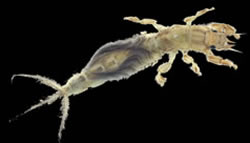 Hexagenia
mayflies are known for their enormous hatches in early summer. The nymphs are
sensitive to water temperature and when river water warms to the right level
they swim to the surface and emerge as winged adults. In some areas of the lower
Flint tens of thousands of mayflies emerge at once. They are often referred
to as "willow flies" because the adults rest on willows and other trees growing
next to the river. Bass and other game fish recognize these hatches and feed
aggressively on mayflies that fall off vegetation and into the water. The adult
mayflies are attracted to street and building lights and can become a nuisance
on road surfaces and parking lots.
Hexagenia
mayflies are known for their enormous hatches in early summer. The nymphs are
sensitive to water temperature and when river water warms to the right level
they swim to the surface and emerge as winged adults. In some areas of the lower
Flint tens of thousands of mayflies emerge at once. They are often referred
to as "willow flies" because the adults rest on willows and other trees growing
next to the river. Bass and other game fish recognize these hatches and feed
aggressively on mayflies that fall off vegetation and into the water. The adult
mayflies are attracted to street and building lights and can become a nuisance
on road surfaces and parking lots.
The adults do not feed and live for only a few days. Males form circular mating swarms, flying up and down to attract a mate. Once mating occurs the females deposit eggs directly on the water surface. The eggs sink to the river bottom and hatch, starting the next generation of burrowing mayflies.
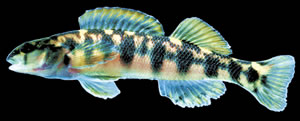 The
Halloween darter (Percina sp.) was discovered by researchers in the early
1990s. It is found only in the Apalachicola, Chattahoochee, and Flint rivers.
It is very abundant in shoals of the upper and lower Flint and some of its tributaries.
The Halloween darter has not been 'named,' a process that involves a formal
description of the species published in the scientific literature. However,
researchers at the University of Georgia are
working on a formal species description.
The
Halloween darter (Percina sp.) was discovered by researchers in the early
1990s. It is found only in the Apalachicola, Chattahoochee, and Flint rivers.
It is very abundant in shoals of the upper and lower Flint and some of its tributaries.
The Halloween darter has not been 'named,' a process that involves a formal
description of the species published in the scientific literature. However,
researchers at the University of Georgia are
working on a formal species description.
The Halloween darter is a small fish, with adults ranging in size from 2 to 4 inches. Its body is banded with dark bars and blotches against a bronze background. The Halloween darter received its common name because males and females develop a bright orange band on their front fins during breeding season in the late spring. Also, all of their other fins are banded with a bright orange wash. Halloween darters live exclusively in swift-flowing shoals and riffles. They use their front fins to rest on the stream bottom. Halloween darters are predators and feed on small aquatic invertebrates that live in shoal areas.
 The
stiped bass (Morone saxatilis) occurs throughout the lower Flint River.
It has a long narrow body that is silver to white with a series of dark stripes
running from head to tail. The head is small with a large mouth and jutting
lower jaw. In the Flint River, these fish can attain a large size, 10- to 15-pound
individuals are not unusual, and occasionally an individual over 30 pounds is
observed.
The
stiped bass (Morone saxatilis) occurs throughout the lower Flint River.
It has a long narrow body that is silver to white with a series of dark stripes
running from head to tail. The head is small with a large mouth and jutting
lower jaw. In the Flint River, these fish can attain a large size, 10- to 15-pound
individuals are not unusual, and occasionally an individual over 30 pounds is
observed.
Striped bass have been adversely affected by humans. In the 1800s millions of pounds of striped bass were commercially harvested annually, resulting in population declines. Striped bass are naturally migratory; they spawn in fresh water in late spring and then migrate to the ocean for the rest of the year. The development of reservoirs prevented annual migration, and landlocked populations developed. However, landlocked striped bass do not attain the large size (up to 100 pounds) reported for ocean-migrating individuals. Striped bass are intolerant of warm water temperatures common in southeastern rivers. In the Flint River, they are dependant on blue holes and other cool water springs where they congregate in large numbers during the warm summer months. Striped bass are predators feeding primarily on shad and other schooling fishes.
The Gulf sturgeon (Acipenser oxyrhynchus desotoi) is one of the larger freshwater fishes. In the 1800s, sturgeon greater than 10 feet in length and weighing up to 800 pounds were commonly harvested from southeastern rivers. Although large individuals are still encountered, they are not abundant.
Like the striped bass, the Gulf sturgeon has been adversely affected by humans. Overharvesting in the 1800s caused severe population declines. The Gulf sturgeon was harvested both for meat and for its eggs, an ingredient in caviar. Gulf sturgeon live in shallow waters of the Gulf of Mexico, but they migrate into rivers in the early spring to spawn. The construction of locks and dams on rivers interferes with migration, further reducing Gulf sturgeon numbers. The Gulf sturgeon once spawned in the lower Flint River, but the construction of the Woodruff Lock and Dam at Lake Seminole in the 1950s stopped the annual migration. Gulf Sturgeon still occur in the Apalachicola River but are rare.
Gulf sturgeon are striking fish. They have a long, V-shaped snout and flat head. The mouth is in the bottom of the head and has a set of barbels in front. The body is covered with leathery skin and a row of triangular plates line the sides of the body. Gulf sturgeon are bottom feeders. They use their snouts to dig through soft mud where they find a variety of worms, mollusks, crabs, and insect larvae. They do not feed during their annual spawning migration in rivers. Because of their large size, Gulf sturgeon have few predators and can be long-lived (up to 100 years). They mature slowly and require 7 to 12 years to reach breeding age.
 Barbour's
map turtle (Graptemys barbouri) is one of the most attractive aquatic
turtles in the Flint River. They have olive green shells and their heads and
legs are patterned with bright yellow and green markings resembling a road map.
They have keel-like spines running across the top of their shell and additional
spines on the shell near their tail. Male Barbour's map turtles are much smaller
than females and are more brightly patterned. Females have strong jaws, which
they use to crush snails and mussels, their preferred food sources. Males have
a more diverse diet that includes aquatic insects and small snails.
Barbour's
map turtle (Graptemys barbouri) is one of the most attractive aquatic
turtles in the Flint River. They have olive green shells and their heads and
legs are patterned with bright yellow and green markings resembling a road map.
They have keel-like spines running across the top of their shell and additional
spines on the shell near their tail. Male Barbour's map turtles are much smaller
than females and are more brightly patterned. Females have strong jaws, which
they use to crush snails and mussels, their preferred food sources. Males have
a more diverse diet that includes aquatic insects and small snails.
The Barbour's map turtle is found only in the Apalachicola, Chattachoochee, and Flint river systems. They are especially abundant in the lower Flint and its tributaries and prefer areas where shoals alternate with deeper areas (5 to 12 feet). Like many aquatic turtles, Barbour's map turtles bask on logs overhanging the stream. They are noted for their shyness, quickly dropping into the water at the first sign of disturbance.
Barbour's map turtles breed from April through July and females deposit more than one clutch of eggs per season. Preferred nesting sites are sandy beaches and sand bars. Barbour's map turtles prefer clean water and populations decline in polluted areas. Since they prefer swiftly flowing areas, the development of reservoirs also contributes to population declines.
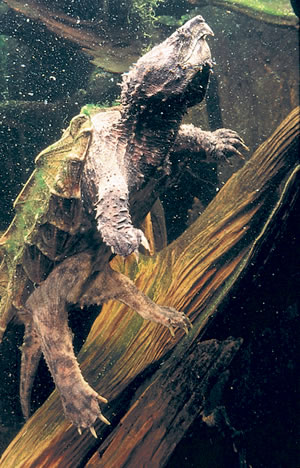 The
alligator snapping turtle (Macroclemys temminckii) is the largest freshwater
turtle in North America. Adults often weigh more than 100 pounds and a few individuals
weighing 200 pounds have been observed. Alligator snappers are primitive-looking
creatures. They have a huge, rough-textured head with a down-turned beak. Their
eyes are surrounded by fleshy "eyelashes." The shell has three parallel ridges
running from front to back.
The
alligator snapping turtle (Macroclemys temminckii) is the largest freshwater
turtle in North America. Adults often weigh more than 100 pounds and a few individuals
weighing 200 pounds have been observed. Alligator snappers are primitive-looking
creatures. They have a huge, rough-textured head with a down-turned beak. Their
eyes are surrounded by fleshy "eyelashes." The shell has three parallel ridges
running from front to back.
Alligator snapping turtles are found in deeper areas of the Flint River and its tributaries. They also occur in swamps and ponds on the floodplain of the Flint River. They are predators and scavengers and feed on a wide variety of animals and plants including fish, aquatic invertebrates, other turtles, acorns, briar roots, and wild grapes. They also have a pink worm-like lure in their mouth. They sit quietly on the bottom with their mouth open and the lure gently wiggling in the current. When a fish comes to investigate, they snap their jaws shut, quickly capturing their prey. They are the only turtle known to possess a lure.
Alligator snapping turtles are declining in the Flint River and throughout the Southeast. The major cause of the decline is overharvesting. Turtle meat is considered a delicacy and is also used for turtle soup. Alligator snapping turtles are long-lived and require 11 to 13 years to reach maturity. Females only lay one clutch of eggs per year and mortality of hatchlings from predators is high. Thus, alligator snapping turtle populations cannot survive high rates of harvest. Georgia considers alligator snapping turtles a threatened species and it is illegal to possess or sell them.
The brown water snake (Nerodia taxispilota) is a common water snake in the Flint River. They have brown bodies with rectangular dark brown blotches down the middle of the back. They also have dark brown blotches on the sides of the body. Their body color can range from light brown to almost black. Mature adults range from 3 to 5 feet in length. They have heavy bodies with large triangular heads and are often mistaken for cottonmouths. Brown water snakes can be distinguished from cottonmouths by the lack of facial pits and lack of a narrow light line on the face. Unlike cottonmouths, brown water snakes are not venomous. Like most snakes, brown water snakes avoid humans and generally flee if disturbed. If cornered or carelessly handled they can deliver a painful bite and secrete a fowl smelling musk. Brown water snakes are excellent climbers and can often be observed in tree branches overhanging the Flint River.
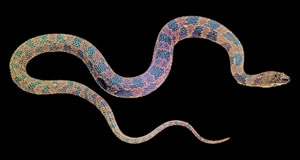 Brown
water snakes eat fish and have a preference for catfish, but they will also
capture other bottom-dwelling fish and frogs. Breeding occurs in late spring
and females give birth to 15 to 50 young in late summer or early autumn. Brown
water snakes prefer slow-moving sections of the Flint River but can also be
found in sloughs, forested wetlands, and freshwater marshes.
Brown
water snakes eat fish and have a preference for catfish, but they will also
capture other bottom-dwelling fish and frogs. Breeding occurs in late spring
and females give birth to 15 to 50 young in late summer or early autumn. Brown
water snakes prefer slow-moving sections of the Flint River but can also be
found in sloughs, forested wetlands, and freshwater marshes.
One of the most colorful breeding birds in North America, the prothonotary warbler (Protonotaria citrea) inhabits swamps and wetland forests throughout its range. While its breeding range extends as far north as the Coastal Plain of the mid-Atlantic states and river valleys of the Midwest, this bright yellow songbird is far more common in bottomland hardwood forests and swamps of the southeastern United States, including the Flint River. The "sweet-sweet-sweet" song of this bird is synonymous with springtime in forested wetlands of the region.
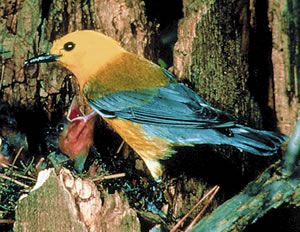 The
bird also has a unique place in our legal and political history. Alger Hiss's
testimony of his excitement at seeing this species along the Potomac revealed
him to have committed perjury when testifying before the House Un-American Activities
Committee. Hiss had repeatedly denied knowing Whittaker Chambers, an ex-communist
who accused him of espionage. Chambers's testimony included details of Hiss's
personal life that only a friend could have known, such as Hiss's sighting of
the warbler along the Potomac. Hiss's independent verification of his prothonotary
warbler sighting was taken as proof that Chambers was indeed telling the truth.
One of Hiss's most visible and fervent adversaries in this interrogation was
Richard Nixon.
The
bird also has a unique place in our legal and political history. Alger Hiss's
testimony of his excitement at seeing this species along the Potomac revealed
him to have committed perjury when testifying before the House Un-American Activities
Committee. Hiss had repeatedly denied knowing Whittaker Chambers, an ex-communist
who accused him of espionage. Chambers's testimony included details of Hiss's
personal life that only a friend could have known, such as Hiss's sighting of
the warbler along the Potomac. Hiss's independent verification of his prothonotary
warbler sighting was taken as proof that Chambers was indeed telling the truth.
One of Hiss's most visible and fervent adversaries in this interrogation was
Richard Nixon.
Wintering in mangroves along the coasts of Mexico and Central America, the prothonotary warbler is one of the earliest migrants in the spring, usually arriving on the Gulf coast by mid-March. The only eastern wood-warbler that nests in tree cavities, prothonotaries are almost always found nesting in trees in standing or slowly moving water. When learning to fly, fledglings that fall in the water have been observed to swim significant distances. Habitat destruction poses the major threat to this species, both on its breeding and wintering grounds. As a result this species is on the watch list of Partners in Flight, a multiagency international bird conservation group.
Cryptic even to its discoverer, the northern rough-winged swallow (Stelgidopteryx serripennis) was first documented by John James Audubon in 1838 when he collected what he believed to be bank swallows. Only later upon closer observation of his specimens did he realize that this was a distinct species. Although relatively common in suitable habitat, this bird is still easily overlooked. The ends of the primary feathers lack terminal barbules and in males even bend up in tiny hooks. This trait gives the bird its name, but it remains unclear what purpose this adaptation serves.
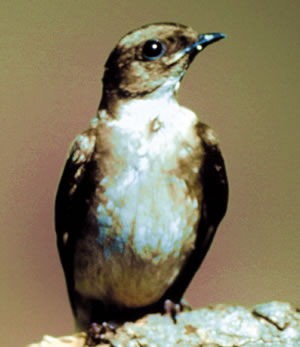 Although
the northern rough-winged swallow is found in a variety of open habitats throughout
its range, it is closely associated with rivers. They nest in burrows in eroded
banks, particularly bluffs, along the river. There is debate as to whether they
excavate their own burrow or utilize existing burrows excavated by other birds
such as kingfishers or even small mammals. While apparently capable of digging
their own burrows, a majority of birds do use existing burrows, and scarcity
of burrows is believed to be a limiting factor in their reproductive success.
Although
the northern rough-winged swallow is found in a variety of open habitats throughout
its range, it is closely associated with rivers. They nest in burrows in eroded
banks, particularly bluffs, along the river. There is debate as to whether they
excavate their own burrow or utilize existing burrows excavated by other birds
such as kingfishers or even small mammals. While apparently capable of digging
their own burrows, a majority of birds do use existing burrows, and scarcity
of burrows is believed to be a limiting factor in their reproductive success.
After raising their young to the fledgling stage (approximately 20 days), young birds take an initial flight and rarely return to their burrow again. Feeding at lower altitudes than most swallows, northern rough-wingeds are commonly seen hawking insects over the Flint River, sometimes dipping their bill down to take prey from the water's surface. Although inconspicuous, they are a fascinating species to observe on and around the river.
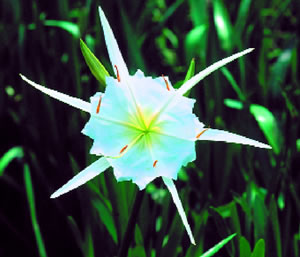 Writing
of his discovery of this plant in the shoals of the Savannah River at Augusta
in the 1770s, the famous early American naturalist William Bartram stated "nothing
in vegetable nature was more pleasing than the odoriferous Pancratium fluitans,
which alone possesses the little rocky islets which just appear above the water."
A true habitat specialist, the shoals spider lily, which has been reclassified
with the Latin name Hymenocallis coronaria, is found in the shallow,
fast-flowing water of river shoals along the fall line in South Carolina, Georgia,
and Alabama.
Writing
of his discovery of this plant in the shoals of the Savannah River at Augusta
in the 1770s, the famous early American naturalist William Bartram stated "nothing
in vegetable nature was more pleasing than the odoriferous Pancratium fluitans,
which alone possesses the little rocky islets which just appear above the water."
A true habitat specialist, the shoals spider lily, which has been reclassified
with the Latin name Hymenocallis coronaria, is found in the shallow,
fast-flowing water of river shoals along the fall line in South Carolina, Georgia,
and Alabama.
The odoriferous quality to which Bartram refers plays an important role in the plant's natural history. Blooming from mid-May through early June, the large, showy white flowers open in the late afternoon and emit a pleasant fragrance throughout the night that wanes the next day as the blossom withers. This fragrance and the light color of the flower attract a species of sphinx moth, which pollinates the lily on nocturnal flights across the shoals. Another unique adaptation to their habitat is the plant's production of pecan-sized seeds that sink, rather than float like other species of spider lily. The seeds' lack of buoyancy allows them to sink quickly into a crevice between the rocks where they germinate in the shoals instead of floating into deeper water where they would not survive.
Found in Georgia in isolated populations along the Savannah, Chattahoochee, and Flint rivers, much of this plant's habitat has been submerged by the construction of reservoirs. Listed as endangered by the state of Georgia, threats to remaining populations include siltation, abnormally lowered water levels from drought and overwithdrawal, and collecting by humans.
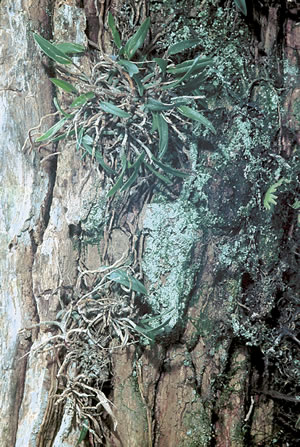 Ranging
from North Carolina to Louisiana, this plant is the only epiphytic (growing
on trees) orchid north of central Florida. Most commonly found growing on live
oak or magnolia trees, the greenfly orchid (Epidendrum canopseum) is
not parasitic. It uses the tree only as a substrate on which to grow. Greenfly
orchids prefer habitats with moist microclimates, such as swamps and riparian
hammocks.
Ranging
from North Carolina to Louisiana, this plant is the only epiphytic (growing
on trees) orchid north of central Florida. Most commonly found growing on live
oak or magnolia trees, the greenfly orchid (Epidendrum canopseum) is
not parasitic. It uses the tree only as a substrate on which to grow. Greenfly
orchids prefer habitats with moist microclimates, such as swamps and riparian
hammocks.
Blooming from mid to late summer, this plant's pale green flowers resemble the shape of a housefly, thus its name. Like many of the light colored tropical orchids, the greenfly is pollinated by moths and is fragrant only during the evening and nighttime hours. Listed as unusual by the state of Georgia, this orchid is sometimes overlooked because of its tendency to grow mixed with other moisture-loving epiphytic plants such as resurrection fern and ball moss.
Corkwood (Leitneria floridana) is a relict species. According to the fossil pollen record, it was once common throughout the Southeast, but now it is relatively rare. Corkwood is a shrubby, small tree sometimes growing in dense clonal thickets. Found in a variety of wetland habitats, it is exceptionally flood tolerant and is also tolerant of brackish conditions. This species occurs in only a few counties in south Georgia, with one population found in the Chickasawhatchee Swamp.
Wood from this tree is exceptionally light, having the lowest specific gravity of any tree in North America. It is more common on the Gulf coast of Florida and Texas, although still rare there. Because of its light weight and buoyancy, wood from the corkwood tree was used by local fishermen to make floats for their nets.
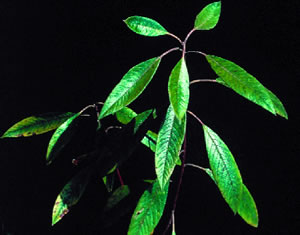 One
of the most unusual ecological communities in the state of Georgia is the Atlantic
white cedar (Chaeaecyparis thyoides) swamp. While usually found
in peat bogs in New England and the mid-Atlantic or in frequently inundated
river swamps along the Gulf coast of Florida and Alabama, Georgia's Atlantic
white cedar communities are found on drier sandy terraces along western tributaries
of the Flint in the fall line sandhills. These Atlantic white cedar communities
represent the most disjunct occurrence of this community and are the only examples
in the state of Georgia. Generally, Atlantic white cedar decreases in abundance
with increasing distance from the coast, and these communities along the Flint
are the most distant from the coast throughout the range of this species.
One
of the most unusual ecological communities in the state of Georgia is the Atlantic
white cedar (Chaeaecyparis thyoides) swamp. While usually found
in peat bogs in New England and the mid-Atlantic or in frequently inundated
river swamps along the Gulf coast of Florida and Alabama, Georgia's Atlantic
white cedar communities are found on drier sandy terraces along western tributaries
of the Flint in the fall line sandhills. These Atlantic white cedar communities
represent the most disjunct occurrence of this community and are the only examples
in the state of Georgia. Generally, Atlantic white cedar decreases in abundance
with increasing distance from the coast, and these communities along the Flint
are the most distant from the coast throughout the range of this species.
Atlantic white cedar is a straight tree typically found in dense stands, with lower branches dead due to lack of light. Its leaves are scale-like, overlapping, and often completely cover the stems. Unique assemblages of shrubby and herbaceous vegetation are often associated with Atlantic white cedar and the extreme conditions in which it thrives. These swamps also provide important habitat for wildlife, especially birds. Surveys in the Great Dismal Swamp in North Carolina showed Atlantic white cedar to be valuable breeding habitat for a variety of species, as well as important wintering habitat for some species. The larvae of one butterfly, Hessel's hairstreak, feeds exclusively on Atlantic white cedar.
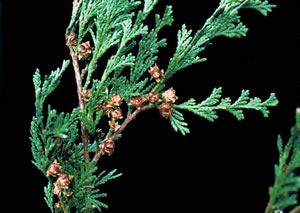 Much
more common at the time of European settlement than it is now, Atlantic white
cedar was logged extensively throughout the last two centuries. Dependent on
the interplay of disturbances such as light- to medium-intensity fires and flooding
for regeneration, altered hydrology, fire suppression, and poor logging practices
are the principal threats to Atlantic white cedar swamps.
Much
more common at the time of European settlement than it is now, Atlantic white
cedar was logged extensively throughout the last two centuries. Dependent on
the interplay of disturbances such as light- to medium-intensity fires and flooding
for regeneration, altered hydrology, fire suppression, and poor logging practices
are the principal threats to Atlantic white cedar swamps.
While cultivated ornamental hybrids from southeast Asia have long been a favorite of southern gardeners, fewer people are familiar with the diversity and beauty of our native azaleas (Rhododendron sp.). Of the 15 species of azaleas native to the eastern United States, 8 are found in the Flint River watershed. Native azaleas range from more common species that are relatively widespread geographically, such as the Piedmont azalea (R. canescens), to rare species with restricted ranges, such as the plumleaf azalea (R. prunifolium). Extremely variable in color within a given species, native azaleas are best identified by season of bloom, habitat preference, fragrance, and geographic range.
For the most part, native azaleas are found in wooded sites with moist soils, such as riparian hardwood forests, although some species, such as Alabama azalea (R. alabamense) and Oconee azalea (R. flammeum) prefer drier sites. Depending on the species, native azaleas bloom from early spring through late summer. Some species are quite fragrant and they are a valuable source of nectar for both butterflies and hummingbirds. One of the best places to view native azaleas is at Callaway Gardens near Pine Mountain.
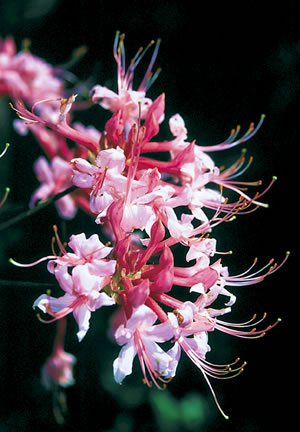 Primary
threats to native azaleas in the wild include habitat destruction and removal
by collectors. Native azaleas should never be collected from the wild; transplants
usually fail and several nurseries in the Southeast now offer a variety of native
azalea species and even hybrids.
Primary
threats to native azaleas in the wild include habitat destruction and removal
by collectors. Native azaleas should never be collected from the wild; transplants
usually fail and several nurseries in the Southeast now offer a variety of native
azalea species and even hybrids.
As the Flint enters the Dougherty Plain physiographic province, the character of its riparian forests changes dramatically. As the river cuts into the underlying limestone, the floodplain becomes narrow, especially compared with the broad floodplain swamps found just below the fall line. Rather than the frequently flooded bottomland hardwood forests characteristic of these wider floodplains, the lower Flint and its tributaries are flanked by a narrow band of more floristically diverse hardwood hammocks.
The diversity of woody plant species in these hammocks rivals and even surpasses that of southern Appalachian cove hardwood communities. This diversity is a result of calcareous soils, variable hydrology, a position in the landscape that provides a refuge from frequent fire, and the confluence of species characteristic of the Coastal Plain with those of more northern affinities at the southern limit of their ranges. Riparian hammocks also feature many unique and rare nonwoody plants, such as several species of trillium, greenfly orchid, atamasco lily, and claytonia. This community has great value as habitat for wildlife, with mast-producing trees such as oaks and hickories providing an important food source. These forests also serve as riparian corridors, facilitating movement of wildlife through the landscape and providing important habitat for breeding and migratory birds, reptiles, and amphibians.
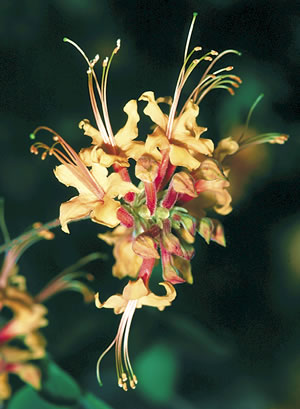 One
of the world's hardiest palms, needle palm (Rhapidophyllum hystrix) has
become a favorite of collectors around the world for its ability to withstand
cold. Although visible damage may occur when temperatures are between 0 and
10 degrees Fahrenheit, plants have reportedly recovered from temperatures as
low as 20 degrees Fahrenheit. While its tolerance to cold temperature has resulted
in translocations that range from the northern United States to Europe, this
plant's natural range is from southeastern South Carolina westward across the
Coastal Plain to southeastern Mississippi.
One
of the world's hardiest palms, needle palm (Rhapidophyllum hystrix) has
become a favorite of collectors around the world for its ability to withstand
cold. Although visible damage may occur when temperatures are between 0 and
10 degrees Fahrenheit, plants have reportedly recovered from temperatures as
low as 20 degrees Fahrenheit. While its tolerance to cold temperature has resulted
in translocations that range from the northern United States to Europe, this
plant's natural range is from southeastern South Carolina westward across the
Coastal Plain to southeastern Mississippi.
This shrubby palm gets its name from the rather stout, sharp needles that spiral outward from its short, fibrous trunk. Usually found in moist, hardwood-dominated forests, needle palm can be found in the Flint River basin in the Chickasawhatchee Swamp and in Magnolia Swamp. This palm has an extremely slow growth rate, only reaching 4 to 6 feet at maturity. Many seeds are infertile and viable seeds may take up to two years to germinate. This low reproductive potential and habitat destruction are the primary threats to this increasingly rare species.
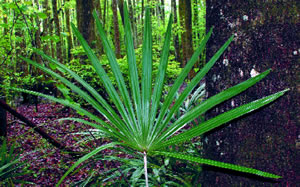 Some
of the special features found along the Flint and its tributaries are relatively
high-quality mesic hardwood forests. A few of the more undisturbed examples
of these forests in the Flint Basin contain a very rare species of trillium,
the relict trillium (Trillium reliquum). Listed as endangered by both
the U.S. Fish and Wildlife Service and the state of Georgia, relict trillium
ranges from South Carolina to southeastern Alabama in three general groupings
of populations. The plant is believed to have once been more widespread, with
these three groups representing relicts of its original distribution, thus the
common name. This plant was described as a new species in 1975.
Some
of the special features found along the Flint and its tributaries are relatively
high-quality mesic hardwood forests. A few of the more undisturbed examples
of these forests in the Flint Basin contain a very rare species of trillium,
the relict trillium (Trillium reliquum). Listed as endangered by both
the U.S. Fish and Wildlife Service and the state of Georgia, relict trillium
ranges from South Carolina to southeastern Alabama in three general groupings
of populations. The plant is believed to have once been more widespread, with
these three groups representing relicts of its original distribution, thus the
common name. This plant was described as a new species in 1975.
The trillium genus dates back 30 million years and contains 38 species, all occurring in the Northern Hemisphere. Trilliums are found in temperate forests of the eastern U.S., the Pacific Northwest, and eastern Asia. Throughout its range, relict trillium is typically found close to streams, creeks, and rivers along the fall line in habitat with high relative humidity. The plant grows low to the ground, producing a single flower that ranges in color from dark purple to yellow. The flower emerges from a single whorl of three leaves that are mottled with blotches of color that vary from dark green to silver.
Trilliums have an intriguing method of seed dispersal and are known as myrmecochorus, or ant-dispersed, plants. The fruit drops to the ground, splitting open and exposing the seeds. Attached to the seeds are elaiosomes, appendages rich in lipids as well as chemicals that mimic the "smell" of ant prey. Ants then carry this package away, consuming the elaiosome and depositing the hard seed in their mound, where the ants protect the seed from being consumed by other creatures.
Primary threats to relict trillium are habitat destruction due to clearing of forest for agriculture or pine plantations and competition from exotic species, particularly Japanese honeysuckle. Recent research has also shown that exotic fire ants have negative impacts on trillium reproduction both by displacing native species of ants that disperse seeds and by fire ants' moving of seeds into unsuitable trillium habitat.
Red buckeye (Aesculus pavia) is a shrub or small understory tree that may reach heights of 20 to 30 feet. It is found in mesic woodlands, along streams and creeks, and in parts of floodplains that seldom flood or flood for short periods of time. The tree has broad, flat palmate compound leaves, usually with five leaflets. Its flowers, which appear in the spring as early as March, are a showy red and borne in groups on panicles 6 to 10 inches long. Red buckeye is becoming popular as an ornamental and is known to attract ruby-throated hummingbirds, which are the primary pollinator of this plant.
Red buckeye is native to the Coastal Plain and lower Piedmont from North Carolina through Texas and is also found north through southern Illinois and Missouri in the western part of its range. Early settlers made a soap substitute from its gummy roots, and Native Americans used the crushed branches of this and other buckeyes to drug fish and make them easier to catch.
Go back to previous page. Go to The Flint River contents page. Go to Sherpa Guides home.
[ Previous Topic | Next Topic ]